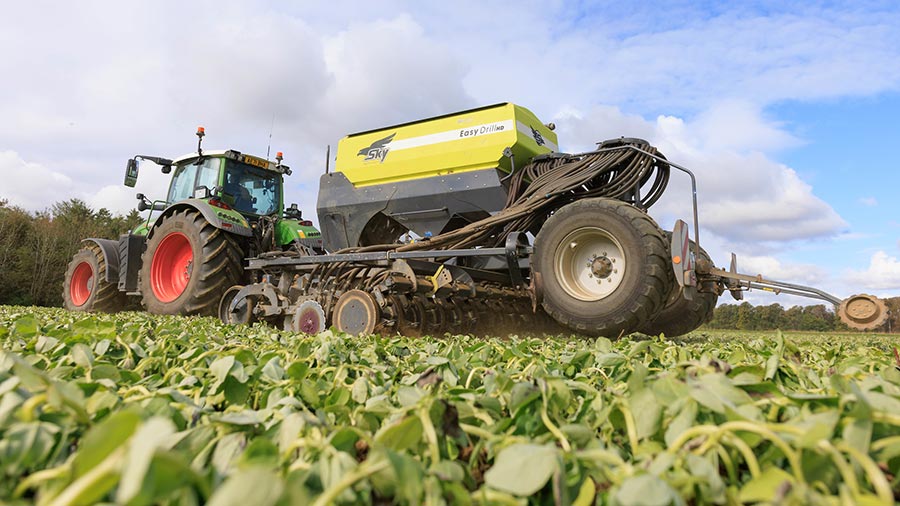Margins narrow to £97/ha for regen and conventional systems
 © Tim Scrivener
© Tim Scrivener The margin gap between conventional and regenerative farming systems has narrowed to £97/ha in favour of the former as labour and machinery costs start to bite, according to four-year average results from the Groundswell Benchmarking Group.
After last year’s blip, when very high yields and rocketing grain prices saw conventional farming systems racing ahead, the latest figures show that while output and margin is still higher from conventional farming, it requires more working capital.
See also: Why it may be time to drop susceptible winter wheat varieties
As Gary Markham of tax and accountancy specialists Land Family Business reported at the event, conventional farming systems now have more than £1,000/ha tied up in machinery and capital equipment.
“For the first time since we started this benchmarking group, the labour and machinery costs on regenerative farms have come in at an average of £129/ha lower.
“The margin is still £97/ha behind, but when appropriate Sustainable Farming Incentive payments are added in, that might look different. For 2023 harvest, we could be at parity.”
He stressed that a key point is the amount of capital required, whichever system is used. “When you look at the working capital tied up in farming, the regenerative farms require £295/ha less. At current interest rates, that’s significant.”
Despite recent price volatility, input costs are also lower in a regenerative system, added Gary.
“Fertiliser use is £64/ha lower, spray costs are more than £26/ha less and seed costs are £10/ha down – giving a variable costs advantage of £134.50/ha.”
Asked whether it makes financial sense to introduce regenerative farming in the present economic climate, Gary replied that it’s important for farm businesses to avoid catastrophic change.
“Make small changes and look at other income streams to help with cashflow.”
Capital requirement – Groundswell Benchmarking Group |
|
| Four-year averages: Regen farming versus conventional | |
| Total variable costs | £134/ha less |
| Machinery capital | £161/ha less |
| Working capital | £295/ha less |
| Access to machinery | £150/ha less |
| Machinery capital | £10/t less |
Making the change: Sentry Farming
The market is interested in regenerative agriculture and there is enthusiasm for being seen as a “good” farmer, said Sentry managing director Paul Christian, who chaired the session on switching farming systems in the current economic climate.
“I like it and I want to scale it up,” he commented. “But no one size fits all and across our 23,000ha it needs to be introduced in a safe and considered way.”
As a result, the business is focusing on three areas – minimal soil disturbance, cover crops and reducing inputs – as it alters its farming practices at a slow and steady pace.
On soil disturbance, Sentry director Alec Smith reported savings of £35-40/ha from dropping one pass and avoiding recreational tillage.
“Understanding your soil is essential – using the right system on the right farm and sharing kit if possible has been important, both for success and financial reasons.
“Where that’s happening, we are saving £100/ha with direct drilling.”
With cover crops, his colleague and rural business adviser Lizzie Ecclestone said that fine-tuning seed mixes and growing them in the right rotational position had been factors, as had an appreciation of any restrictions on funding eligibility.
“On our heavier land, only two or three mixes are suitable for the task,” she said.
“We’ve also had to maximise the use of grants and funding to cover their costs and work with others to bring livestock in to graze them.”
Improving fertiliser recovery has been a key part of the company’s push to reduce inputs, added Alec.
“We are making good use of technology as part of that, looking at variable rate and on-line systems, as well as trialling robots.”
Sentry’s use of the N-tester saved up to 50kg/ha of N last year, with the average 30kg reduction being worth £55/ha, he revealed.
“We aimed for 85% nitrogen use efficiency and averaged 92%, by regular crop monitoring and tweaking of nitrogen rates.”
Sentry’s key learnings
- Focus on business profitability
- Make small changes and go slowly
- Find opportunities to offset costs

